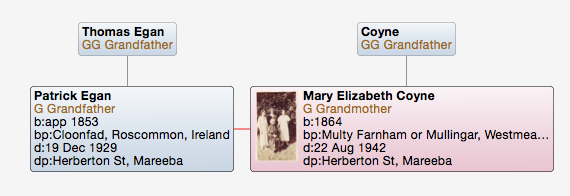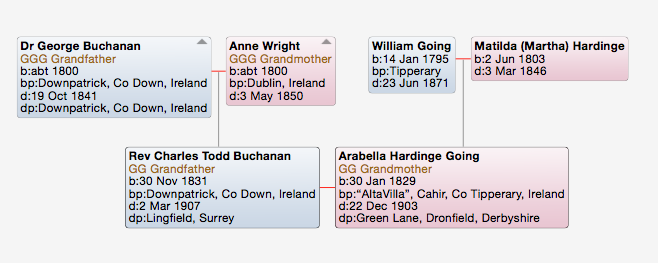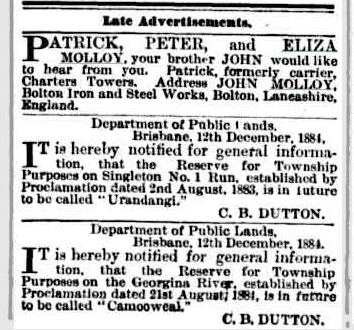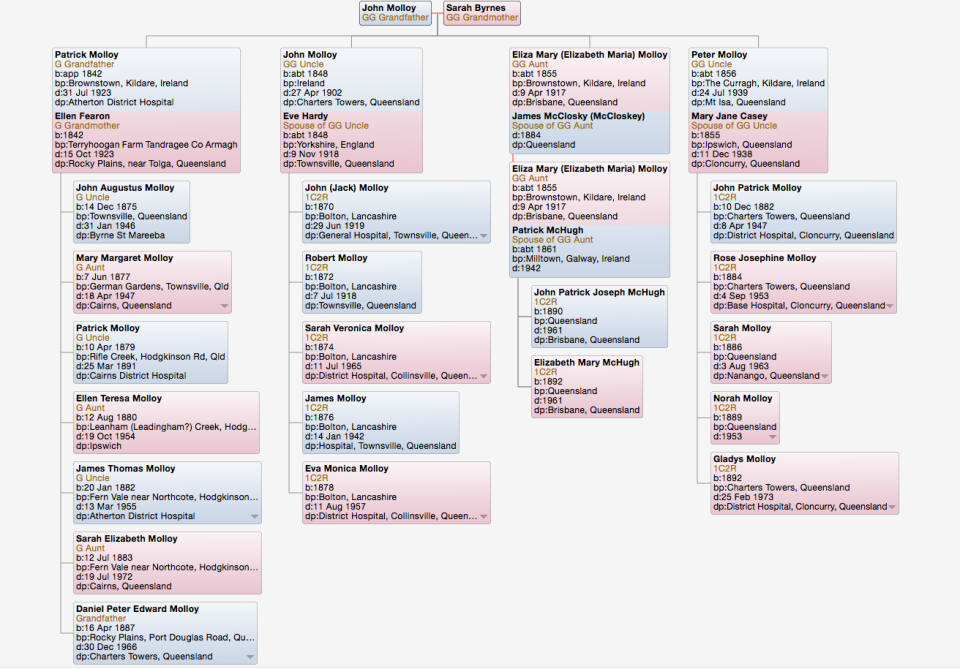Patrick Molloy, my great grandfather (maternal), arrived in Queensland in the 1860s. According to his obituary he is reported to have arrived in 1863, but as he paid his own fare (rather than being an assisted immigrant) his actual arrival date is not so easy to track down. On the other hand, the journey of his future wife Ellen Fearon is more easily documented.
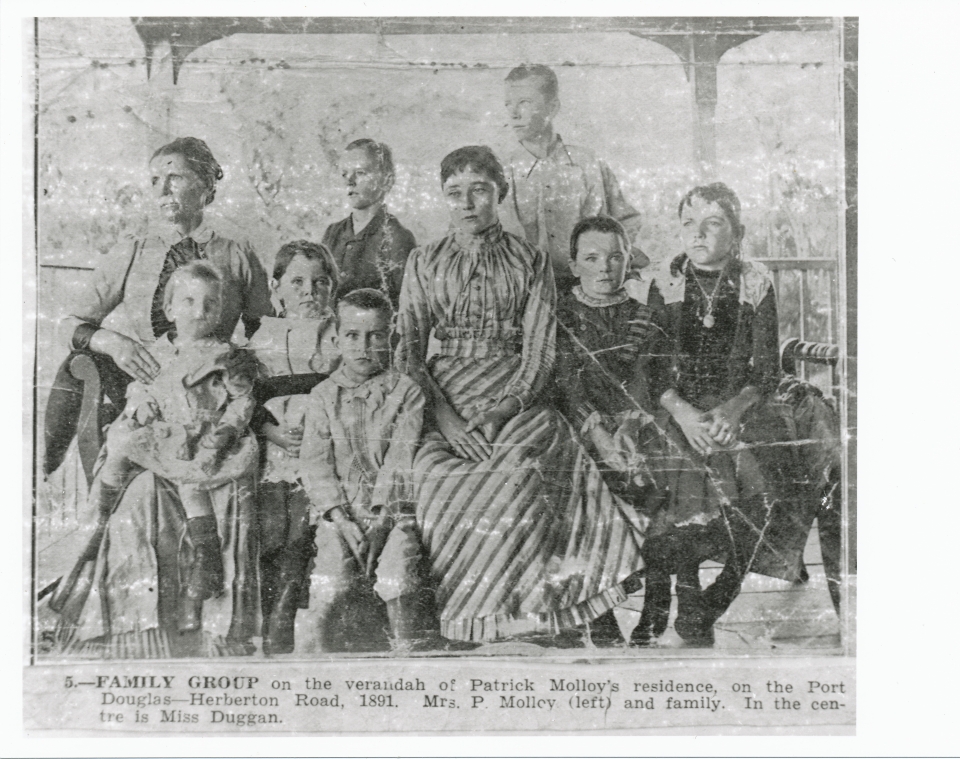
Mrs Ellen Molloy, her children and Miss Duggan (governess?) at their Rocky Creek home, 1891 (Courtesy State Library of Queensland)
Ellen (sometimes called Eleanor) Fearon came from Cargans or Tandragee Townland, County Armagh in what is now Northern Ireland. The birth registration for her third child, Patrick, pinpoints her place of birth as Terryhoogan Farm, Tandragee, Co. Armagh. She was one of at least seven children of father Daniel Fearon, farmer, and mother Mary Farrell, of Tandragee. Three of her siblings also migrated to Queensland. According to Wikipedia, earlier spellings of the town’s name include Tanderagee and Tonregee (Ellen’s birthplace on her marriage certificate is given as Condriggy – could this be a misspelling or misheard pronunciation of Tonregee?).
Ellen aged 24, travelled on the ship Southern Belle, departing London on 16th November 1873, and arriving in Rockhamption over three months later, on 6th March 1874. There were 418 “souls” on board, with three births and five deaths during the voyage.
The account of the ship’s journey in the Rockhampton Bulletin (Monday 9 March 1874) starts well:
The ship Southern Belle, 1128 tons register, William Addison Carpenter, commander, left the East Indian Docks on the 14th and Gravesend on the 16th November ; passed Lizard Point (the southern most point of Cornwall) on the 18th, at 7 a.m. ; crossed the Line on the 17th December : passed Fernando Noronha [islands approx 350 km offshore from the coast of Brazil] on the 23rd ; was off the Cape of Good Hope on the 15th January, and made east in latitude 41°; passed South Cape (southern most point of Tasmania) on 17th February; sighted the east coast of Tasmania on the 19th ; and on the 25th sighted Moreton Island, about twenty-five miles distant. Up to this date, had generally fair and agreeable weather.
From this point on the ship encountered bad weather and it was obviously the experience of its mariners that kept it safe for the remainder of its journey up the Queensland coast.
On the 25th February, when off Moreton Island, had light northerly winds, and made no progress, although carrying all sail ; thc barometer was steady at fair ; about 4 p.m. black clouds began to rise from the southward, the wind varied to all parts of the compass, heavy squalls and calms alternating, sometimes with great suddenness and rapidity ; about 8 p.m. the wind began to blow hard from the southward, and a strong sea making, the ship laboured heavily ; at 11.30 p.m., carried away the main topgallant and royal masts, the sea still making and the ship labouring very heavily, and taking on board large quantities of water.
At midnight it blew a hurricane ; to ease the ship cut away foretopsail and the rigging of the mainmast, which immediately snapped off close to the deck, taking with it the mizmtopmast, and all the mizenmast yards ; at 4 a.m. on Friday, the foretop-gallant and royal masts carried away, the ship still labouring heavily ; set foresail to steady the vessel ; afterwards the sail was blown to pieces, but was soon replaced by another ; of seven boats on board, three were smashed by the falling spars, and one of the remaining four was only a dingy ; the pumps were also broken below the deck, and rendered temporarily useless ; by the evening of Friday the weather moderated ; cleared away a great deal of wreck, got temporary stays up, and set sundry stay sails ; on Saturday morning made for Curtis Channel, the wind being S.E., but afterwards finding that the ship was too far to the northward to work into Curtis Channel, and taking into consideration her crippled condition, the attempt was abandoned, and she ran for Capricorn Channel ; on Sunday, 1st March, sighted Barren Island, S.W. by W., distant about eighteen miles ; finding the wind not fair for Keppel Bay, shaped the ship’s course northward, until at 11.30 a.m. she reached a point about three miles southward of the Bluff,
beyond Waterpark Creek (north of Yeppoon – the ship’s original destination was Townsville), where she dropped anchor in ten fathoms of water, paying out sixty fathoms of chain ; the ship here rode at anchor until Wednesday the 4th March, when she was taken in tow by the steamer Mary. Her position was about twelve miles north-east of Bald Hills, and 37 miles from the Keppel Bay Pilot station.
At the time when the ship anchored, the wind was moderate from the S. E.; on the following morning (Monday), sent the lifeboat in charge of the second officer, four seamen, and two passengers (one of whom had formerly visited Rockhampton), to endeavour to obtain assistance ; after the boat left, the wind blew strong, from S.E. to E. throughout Monday and Tuesday ; the Mary hove in sight on Wednesday about 11 a.m. ; the passengers became greatly excited with the prospect of relief ; the guns were got out, and half-a-dozen cartridges fired off, and on the steamer coming alongside, it was welcomed with hearty cheers. Pilot Haynes, who was in charge of the tug, said he would try to tow the ship. A hawser was quickly attached, the anchor came up cheerily, and the ship moved on in tow of the little steamer at a speed of about three knots an hour, reaching Sea Hill (on Curtis Island in Keppel Bay, at the mouth of the Fitzroy River) in safety at 1 a.m. on Thursday.
It would have been a worrying final week for Ellen and the other passengers onboard. Just as well the anchor came up cheerily!
The family story is that Patrick Molloy and Ellen Fearon met and married in a few weeks. The dates bear that out – she disembarked in Rockhampton on 6th March and was married to Patrick in St Joseph’s Catholic Church, Rockhampton, on 19th March 1874. They were married for 49 years until both died in 1923 within a few months of each other.
Three of Ellen’s siblings also migrated to Queensland (ages given are those on the passenger lists):
- Sister Margaret Ann Fearon had travelled out in 1869 aged 22 on the Royal Dane, sailing from Plymouth on 2 July and arriving in Brisbane, Queensland on 25 September 1869.
- Brother Bernard Fearon, aged 18, arrived on the ship Darling Downs in the same year as Ellen, departing from London on 25 July and arriving in Brisbane on 5 November 1874.
- Another brother, John Fearon who lived near the Molloys at Rocky Plains near Mareeba, arrived on the Kapunda, departing from Belfast on 25 July and arriving in Townsville on 17 November 1875. He was 21.
More about the Molloy family in a later post. As regards Margaret Ann Fearon, she married Martin Hind in 1877 in Townsville, had six children (Ellen, Margaret, Edward, James, Rose and Mary) and seems to have settled in Townsville where she was living when she died in 1927, aged 73 years.
John Fearon worked as a grazier in the Mareeba area but did not marry. He died in 1912. His headstone in the Pioneers Cemetery in Mareeba reads: In loving memory of John Fearon who departed this life 23rd Oct 1912. Aged 56 years. R.I.P. Erected by Daniel P.E. Molloy, Rocky Plains. My grandfather was the executor of his will (Townsville Daily Bulletin, Monday 9 December 1912):
Probate of the will of John Fearon, late of Rocky Creek, near Mareeba, grazier, deceased, was granted by the Registrar (Mr Chas. S. Norris), at the Supreme Court on Saturday, to Daniel Peter Edward Molloy, of Rocky Creek, stockman, the sole executor named in the will. (Messrs MacDonnell, Henchman and Hannam, as town agents for Mr E. L. Havard, solicitor for executor.) Realty under £101; personalty under £2120.
Bernard Fearon does not appear to have married. He died in 1928 at about 72 years of age at the Eventide Home, Glenrosa Road, Red Hill, Brisbane and is buried in Toowong Cemetery. Electoral roll records indicate that he was living in Brisbane since at least 1913.
The family that Ellen left in Tandradgee in Armagh consisted of at least seven children. A search through the Irish Family History Foundation (RootsIreland) website shows the following records for Daniel Fearon and Mary Farrell, with varying name spellings:
- Church record – Marriage: 16 November 1835 at Ballymore Parish, Co. Armagh – Danl Feran and Mary Farrel; witnesses Thos Vallely, James Farrel
- Edward Fearon born about 1838; baptism not located. Church and civil marriage record: Married in 1879, address Terryhoogan; father’s name Daniel Fearon
- James Feron: Church record – Baptism: 23 Feb 1838, at Ballymore Parish, Co. Armagh. Father Danl Feron; mother Mary Farrell; sponsors Elizabeth Lay
- Mary Feron: Church record – Baptism: 21 June 1840, at Ballymore Parish, Co. Armagh. Father Daniel Feron; mother Mary Farrell; sponsors Roseanne Farrell, John Feron
- Elenor Fearon: Church record – Baptism: 18 June 1842, at Ballymore Parish, Co. Armagh. Father Daniel Fearon; mother Mary Farrell; sponsors Patrick Farrell, Elenor Fearon
- Margret Fearon: Church record – Baptism: 10 Sept 1846, at Ballymore Parish, Co. Armagh. Father Daniel Fearon; mother Mary Farrelly; sponsors Alice Fearon, John Fearon
- John Fearon: Church record – Baptism: 4 June 1851, at Ballymore Parish, Co. Armagh. Father Daniel Fearon; mother Mary Farrelly; sponsors Thomas MacKan, Margaret McKan
- Bernard Feron: Church record – Baptism: 13 July 1855, at Ballymore Parish, Co. Armagh. Father Daniel Feron; mother Mary Farrelly; sponsors Joseph Rice, Bridget Walsh.
- Civil record – Death: Daniel Fearon, age 62, date of death 5 July 1873, address Terryhoogan, Banbridge Parish, Co. Down, occupation farmer
- Civil record – Death: Mary Fearon, age 78, date of death 27 Sept 1886, address Terryhoogan, Banbridge Parish, Co. Down, occupation farmer’s widow
According to the FamilySearch website, the Catholic parish of Ballymore in Co. Armagh is the head of a district called Tanderagee that also includes the parishes of Acton and Mullaghbrack. For civil registrations, the place name of Terryhoogan occurs within the poor law union of Banbridge, within the civil parish of Ballymore, in the registrar’s district of Tanderagee, and in the county of Armagh. Banbridge civil parish may have extended across the border with Co. Down, which adjoins Co. Armagh to the east, which accounts for Daniel and Mary’s death records falling within Co. Down rather than Co. Armagh. Ellen’s place of origin was also sometimes given as Cargans, Armagh – this was another townland within the Tanderagee rural area.
The Griffiths Valuation published its census of Co. Armagh in 1864. At that time there was a Daniel Ferrin occupying land leased from the Duke of Manchester at Terryhoogan townland, consisting of house, offices and land, with a total annual valuation of rateable property of £28 10s. Amongst neighbours there were Farrells as well as Thomas Vallely, witness at Daniel’s marriage.
Assuming that this is the correct family, there appear to have been seven children born to Daniel Fearon and Mary Farrell, of Ballymore parish. But the dates of birth conflict with stated ages for those siblings who migrated to Australia. For a birth in 1842, Ellen (Eleanor) would have been 32 rather than 24 when she migrated and married Patrick Molloy, aged 45 when she had her last child Daniel, and aged 81 years rather than 79 years when she died.
Of Ellen’s remaining siblings in Ireland:
- her older sister Mary Fearon married John Woods in 1877, also farming in Cargans in Tandragee. They had one daughter, Isabella or Bella, who married James McKiernan in 1899 and subsequently had three sons (if not more children).
- her eldest brother Edward Fearon married Mary Donnelly in Tandradgee in 1879. He was then 42. When he died in Tandragee in 1894, his executor was his brother-in-law, John Woods.
- I have yet to identify the details for James Fearon, Ellen’s second eldest brother, but so far have not located any marriage or death records.
Ellen’s experience on board the Southern Belle did not dissuade her from further voyages. According to the Molloy obituary in the Cairns Post (30 October 1923), she returned to the old country by ship with her daughter, Ellen Teresa Molloy:
In 1907 Mrs. Molloy, who had been in indifferent health for some time, went for a trip to Ireland; taking her second youngest daughter, now Mrs. W. Hayes, with her. Mr. Molloy, who
could not be persuaded to overcome his dread of a long sea voyage, would not go. Mrs. and Miss Molloy stayed away 12 months and landed back in time to have Christmas at Rocky
Plains in 1908.
Possibly the family they were visiting were the remaining Fearons at Tandragee (as well as any Molloys in Co. Kildare). Ellen’s father had died the year before she migrated to Australia and her mother had passed away in 1886.

Family of Daniel Fearon and Mary Farrell (click to open in new window)
Ellen’s sister Mary had died in 1894. According to the 1901 Ireland census, her husband John Woods was a widower, living at Cargans, Tandradgee with their daughter Isabella and her husband James McKiernan, and an Ellen Fearon, age 17, born in Liverpool. John Woods and the family were present in the same location at the 1911 census, now with three grandchildren added. Edward had died in 1894, and I am unsure of when his wife Mary died. She was still alive in 1886 as she was the informant for her mother-in-law Mary Fearon’s (nee Farrell) death certificate.



